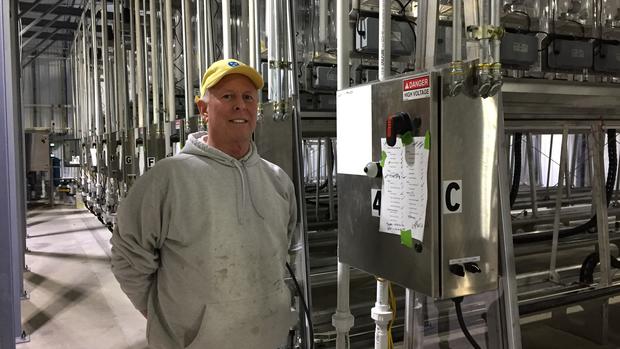NEW LONDON—What had been a large, empty pole barn on a farm in rural New London last year is now becoming a climate-controlled maze of computer-operated, high-powered lights and a water misting system housed on a dozen massive stainless steel frames.
By early spring, the building will be filled with lush, fresh lettuce and other leafy greens.
Grown without soil, pesticides or herbicides, the greens will taste “like a treat,” said Kevin Ortenblad, who along with his wife, Julie, and daughter and son-in-law, Brian and Melody Dengler, are launching Lettuce Abound Farms LLC.
It will be the region’s first large-scale, commercial indoor aeroponics growing system that will produce fresh greens year-round.
They intend to market the high-end produce to restaurants and other outlets, like food co-ops.
“Our goal is to be able to supply this part of the state with all of the leafy green products,” Ortenblad said.
Because plants are grown in numerous trays that are stacked vertically in rows that are 8 feet high and 32 feet long, the growing capacity of the building is the equivalent of 180 acres of cropland, Ortenblad said.
Fed with a nutrient-rich mist that’s continually sprayed on the roots by a trolley system that traverses back and forth along the rows, the aeroponics method will use about 5 percent of the water used in conventional farming, he said.
The science of farming
Ortenblad is no stranger to farming.
For more than 30 years he farmed in Priam, near Willmar, and found a niche market of selling organic soybeans to Japan.
The family then moved to Colorado, where he and his wife were involved with Christian ministries. They moved back to Minnesota a year ago to be closer to family and began looking for a business venture.
That’s when they heard about a Faribault company, called Living Greens Farm, that developed the technology to grow aeroponic greens on a commercial level.
“I thought, ‘I can do that,'” said Ortenblad, 62, who confesses the learning curve has been steep, especially when it comes to the computer programming of the automated systems.
Ortenblad and Dengler worked at the Faribault facility for six weeks learning the ropes.
“They shared a lot of secrets with us,” said Ortenblad, adding that they have a “sister farm” relationship with Living Greens Farm.
“They’ve been very helpful,” he said of the crew at Living Greens, which includes New London-Spicer graduate Dana Anderson, who is president and chairman of the Faribault company.
After purchasing the equipment and patented technology from Living Greens Farm, Ortenblad and Dengler began assembling the system at their farm in New London.
“It’s been an enormous amount of work,” Ortenblad said.
The investment of up-front time and money has been more than what he had initially expected, but Ortenblad said the complex system is nearly complete and seeds will be planted this month.
When seedlings are moved from the nursery into the vertical trays, they will be anchored with a product called “rock wool” but the roots will dangle in the air and be spritzed with a mist every five or six minutes.
Computers programmed with exactly what nutritional balance plants need at each phase of the growing season will spoon feed liquid fertilizer, micronutrients, macronutrients and filtered water into tubes and sprayers that will glide along on tracks to steadily mist the roots of the plants.
Any excess water that drips down will be returned to the tanks in the closed-loop system.
“This is not farming. This is science,” Ortenblad said. “This is science and computer automation is what this is, with farming a cool side part of it.”
With a constant temperature of 70-72 degrees and humidity of 60-65 percent, he said farming indoors will have its advantages.
“No hail, no dust, no wind, no cold,” he said. “That’s the environment I’ll get to farm in.”
There is about four pounds of pressure in the building, which will help prevent dust and bugs from entering the environment, he said. If aphids do enter, beetles will be released to eat them.
Fans will be used to replicate air flow to help strengthen plants and the system also includes 126,000 watts of light bulbs that will replace the sunshine.
“The power company is going to be our best friend,” Ortenblad said.
To augment the science, Ortenblad said he intends to play Christian music in the indoor garden to help inspire the plants to grow. He also said there are hundreds of handwritten Bible verses inside the walls in a nod to the family’s core values for their new business.
Year-round greens
The variety of greens that will be grown at Lettuce Abound Farms, like oak leaf lettuce, arugula and butter lettuce, will be harvested about four weeks after germination.
Microgreens—young, tender plants with intense flavor—will be harvested about two weeks after germination.
Because they are herbicide- and pesticide-free, Ortenblad said the greens don’t need to be washed before being put on the table, which he said also extends their shelf life.
“I’ve never tasted lettuce as good as what Living Greens gave us and what we will be growing,” he said.
Ortenblad said he hopes others will also appreciate the flavor and having year-round, locally grown produce raised without pesticides or herbicides.
The cost of the fresh greens will likely be more than typical grocery store prices, but Ortenblad said it will be worth it.
West Central Tribune by Carolyn Lange

